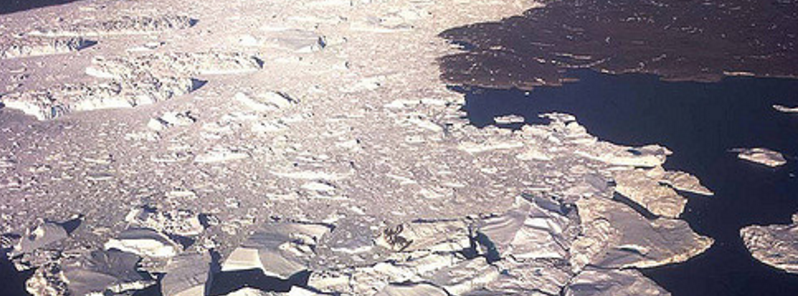Ice melting 10 000 years ago caused radical climate shift in Europe and Africa

A team of researchers led by the Ruhr-Universität Bochum investigated how the meltwater from the ice sheet in North America produced a massive impact on climate conditions in northwest Europe and northwest Africa by the end of the most recent ice age, about 10 000 years ago (early Holocene period). The ice sheet melted in the way similar to Greenland ice today, and the scientists think it may provide them with an insight into how the current melting may affect our current climate.
The scientists analyzed dripstones from the caves, called the speleothems and used computer simulations to reconstruct what happened in the period between 11 700 and 8 000 years ago. During present day, a negative correlation in the rainfall amount from northwestern Africa and northwestern Europe was observed. The climate in African region is dry while the humid winter conditions are present in the European region. This correlation was reversed during the early Holocene, meaning both areas were simultaneously dry and a radical climate change occurred.
The winter climate conditions in northwestern Europe and the Mediterranean are ruled by the North Atlantic Oscillation (NAO), the variation in the atmospheric pressure difference between the Azores high pressure field in the south and the Icelandic low pressure field in the north. The goal of the research was to determine how this oscillation will respond to ice melting in the North Atlantic.
Research indicates the ratio of the 18O and 16O oxygen isotopes from speleothems is also affected by the rainfall amount. On a scale of several decades to several centuries, a negative correlation between the rainfall in both regions between 8 000 to 5 900 and 4 700 and 2 500 years ago has been established, based on the speleothems from northwestern Morocco and western Germany.
The results mean that one area had less rainfall than the other, just like the present day. But, during the early Holocene, a positive correlation has been observed between the regions and it reversed in the period from the mid to the late Holocene.
To find out what is causing such a behavior, the scientists used a coupled atmosphere and ocean model to carry out the climate simulations.
“A possible explanation for the negative correlation is the melting of the North American ice sheet in the early Holocene period,” explained Jasper Wassenburg, who conducted the analyses in collaboration with Prof Dr. Adrian Immenhauser at the Department of Sediment and Isotope, Geology at the Ruhr-Universität Bochum.
During the most recent ice age, this ice sheet covered large areas of Canada and massive amounts of meltwater flowed into the North Atlantic, changing the circulation pattern.
“Using the simulations of our climate model, we demonstrated that the positive correlation of rainfall in Morocco and Germany is caused by a combination of effects: namely the impact of the North American ice shield on the atmospheric circulation and the impact of its meltwater on the oceanic circulation,” said Dr. Stephan Dietrich, who evaluated the simulations at the Alfred-Wegener-Institut, Helmholtz-Zentrum für Polar- und Meeresforschung and is now at the Bundesanstalt für Gewässerkunde in Koblenz.
Oscillations such as the NAO, result from the heating and cooling of air which affect the atmospheric pressure field. Ocean currents affect the heat distribution, and thus, also the atmospheric circulation. The North American ice sheet produced a strong cooling effect, as it reflects the solar radiation, and a stable high-pressure field develops above the ice sheet. The meltwater impacts the strength of ocean currents, in particular the North Atlantic Current.
“Even though the precise mechanisms have not yet been fully understood, it is very likely that these effects were essential factors that caused the positive correlation of rainfall in Morocco and Germany to reverse into a negative one, due to the melting of the North American ice sheet,” said Jasper Wassenburg.
A similar case to the one which induced the NAO change during the early Holocene may be possible, researchers concluded.
“However, the climate conditions in the early and late Holocene differed considerably. This is why it is difficult to predict if and how NAO will be affected. We suggest that it all depends on the speed at which the ice in Greenland will melt and on the volume of meltwater. Detailed reconstructions of the climate and precise measurements of the changes in Greenland ice are necessary in order to understand the mechanisms that contribute to the changes in correlation patterns.
Reference:
- "Reorganization of the North Atlantic Oscillation during early Holocene deglaciation" – Jasper A. Wassenburg, Stephan Dietrich, Jan Fietzke, Jens Fohlmeister, Klaus Peter Jochum, Denis Scholz, Detlev K. Richter, Abdellah Sabaoui, Christoph Spötl, Gerrit Lohmann, Meinrat O. Andreae and Adrian Immenhauser – Nature Geoscience (2016) – doi:10.1038/ngeo2767
Featured image: Icebergs spilling out of Jakobshavn Fiord from the Greenland Ice Sheet, seen on the horizon, December 4, 2009. Image credit: Oregon State University (Flickr-CC)

This around the time period that Edgar Cayce (the Sleeping Prophet) said that the last ‘Pole Shift’ occurred.